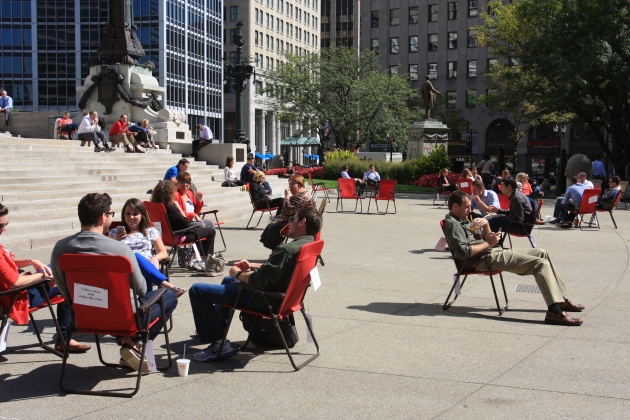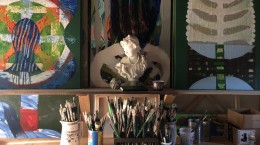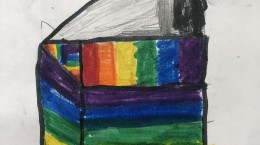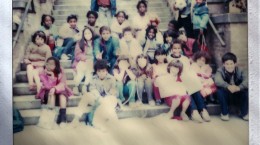Subscribe to Blog via Email
Recent Posts
Recent Comments
- Dante Ventresca (RSS) (110)
- Rebecca King (RSS) (35)
- Brad King (RSS) (18)
Authors
Chairs / 10-28-13

I figured out something today – it’s not about the chairs:
(excerpts)
3:02 a.m. I send out a handful of invitations via e-mail and text. In the invite I include a photo of the chairs the last time we set them out. The Circle Tower Building dominates the background. In the foreground three people are sitting in red chairs. You can almost see the word bubbles coming out of their mouths.
8:06 I load the chairs into my truck – 31 degrees outside. My hands are frozen. In my mind I’m trying to design a way to keep the chairs warm for sitting. This doesn’t help my hands.
10:29 I arrive on the Circle at the center of the city. I turn off the engine and survey my surroundings.
10:33 Rebecca pulls into the parking place behind me. I think to myself, “This is cool. This is what happens in the best places to live: people run into each other and make contact with one another without coordinating it – no text, no phone call, no GPS.” I think this is all I need from the Chairs Remix. I’m ready to go home. 40 degrees outside.
11:02 We get the chairs unloaded and stacked on the limestone steps of the monument. I wonder if the quarry these stones came from is closer to the quarry where the Empire State Building was mined or the quarry that gave us San Francisco’s City Hall? I’m secretly glad to be back. The sun has formed a warm spot at the southeast corner. This is where we put the first chair.
11:23 A woman on her break sits in a chair near street level. As I walk past with two chairs in each hand she says, “They (the chairs) work perfectly. Thank you.”
11:32 Following the sun while carefully considering the shadows Rebecca and I recreate the array of chair-based invitations: “Take a seat and enjoy the view.”
11:36 / A man takes a seat near the center of the installation and finds a purpose for chair: to make a business call.
11:41 People suddenly appear from all directions. Their reactions to coming upon the chairs range from curiosity to engagement to uncertainty. I remind myself of one of our design imperatives – no direct interventions unless required for purposes of safety. Everybody ends up taking a seat.
11:44 The body language of the man making the business call changes signaling that he has found another use for the chair he’s chosen – to make a personal call. He relaxes.
11:48 I discover, almost by accident, that south Meridian Street constitutes what can be classified as a “view”. This is particularly true from the top steps. The visiting tourists showed me. I just followed the direction they were pointing their cameras. Maybe tourists can aesthetically understand a place better than its natives? Just a thought. Rebecca reassures me that this is a valid line of inquiry.
11:52 / Two friends, you can tell, make their own reason for the chairs- conversation.
12:19 Folks behave like true folks. They begin to move the chairs about rearranging the original design for their own purposes. Some chairs are lifted out of the shadows into the sunlight while others are pulled up the steps. Lunches are shared, moments of stillness in an otherwise blurred day are found, phone calls are made, hands are held, a book is read.
12:22 Rebecca does an interview with a reporter who dropped by. The core question is a beautiful one: Where’s the art in the chairs? It comes up that we are artists, that we design experiences set within a designed world. I’m reminded of one of our other design imperatives for “Indy Loves You” of which the chairs are a part – no artists’ statements, no instruction booklets, no tours.
12:53: I see one of the chairs in a group of four chairs has been moved with its back facing the other three closing off the shared space between the set of four. No one has used these chairs since the one chair has been relocated. I take this chair and pair it with another chair sitting by itself. Within a minute of making this design adjustment all these chairs are filled.
12:55 I read a sign with valuable information about the birds nesting around the Circle. I find another excuse to see my surroundings with a greater sense of intimacy.
12:58 Four office mates arrive with their bag lunches at a set of three chairs. The four of them are looking about with hesitancy. Reading their faces a lone woman sitting in a chair ten feet away calls over, “You can move any of the chairs you want.” The group waves in thanks. One of them grabs a chair and they all sit down together.
1:00 I suddenly hear the water fountains behind me for the first time.
So I think I get it – it’s not about the chairs. I remember a Zen saying – something about the finger pointing at the moon isn’t the moon. But the idea of someone pointing at things, of indicating interest to a friend, of positioning oneself to be enthralled by the everyday? This seems like a really good idea. Maybe it turns out (to misquote Picasso) that the chairs are the lie that reveals the truth? It’s not about the chairs. It’s about the people sitting in them.



